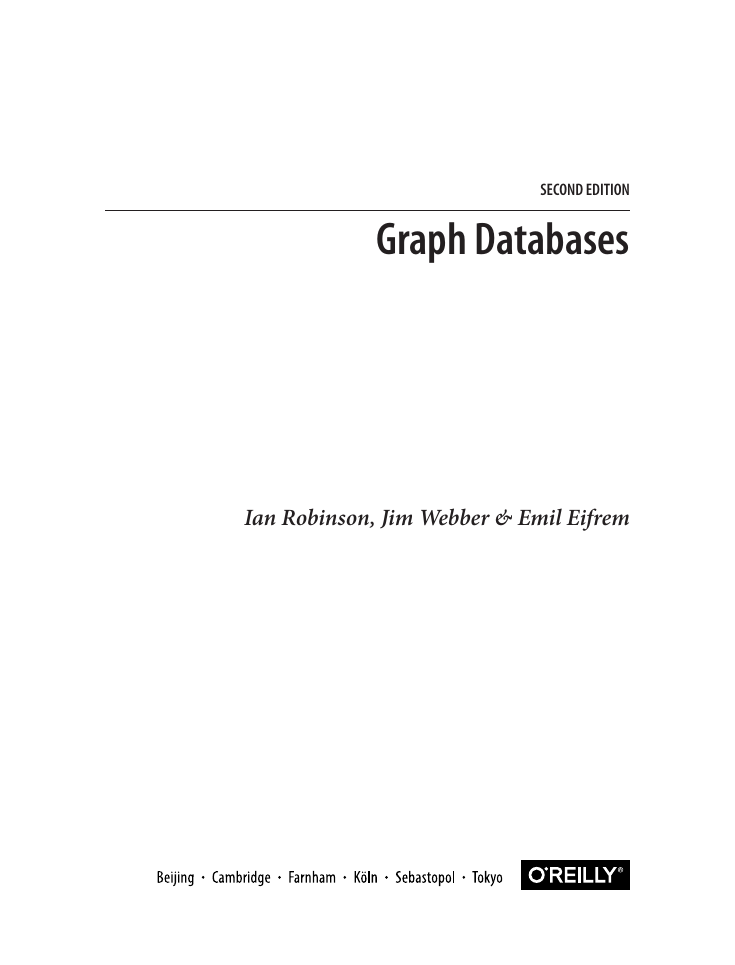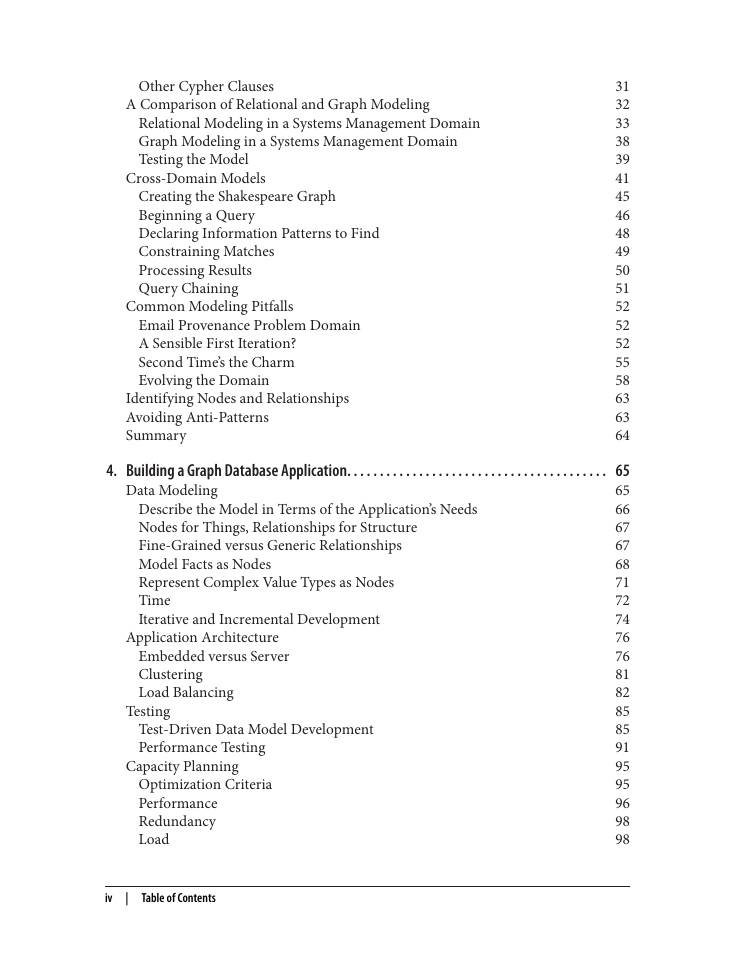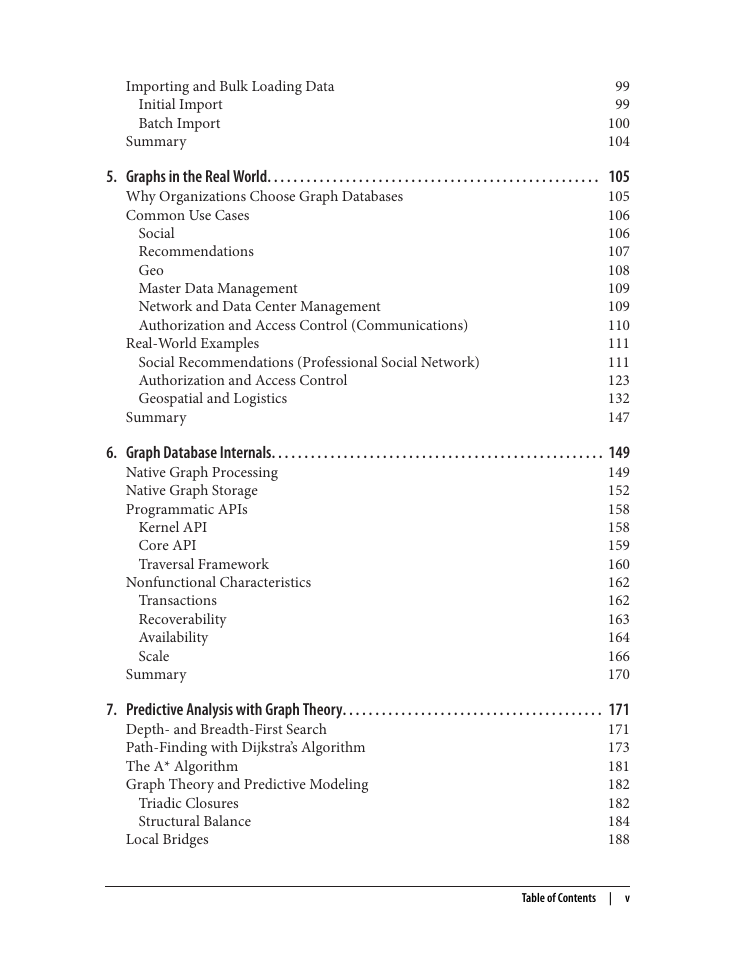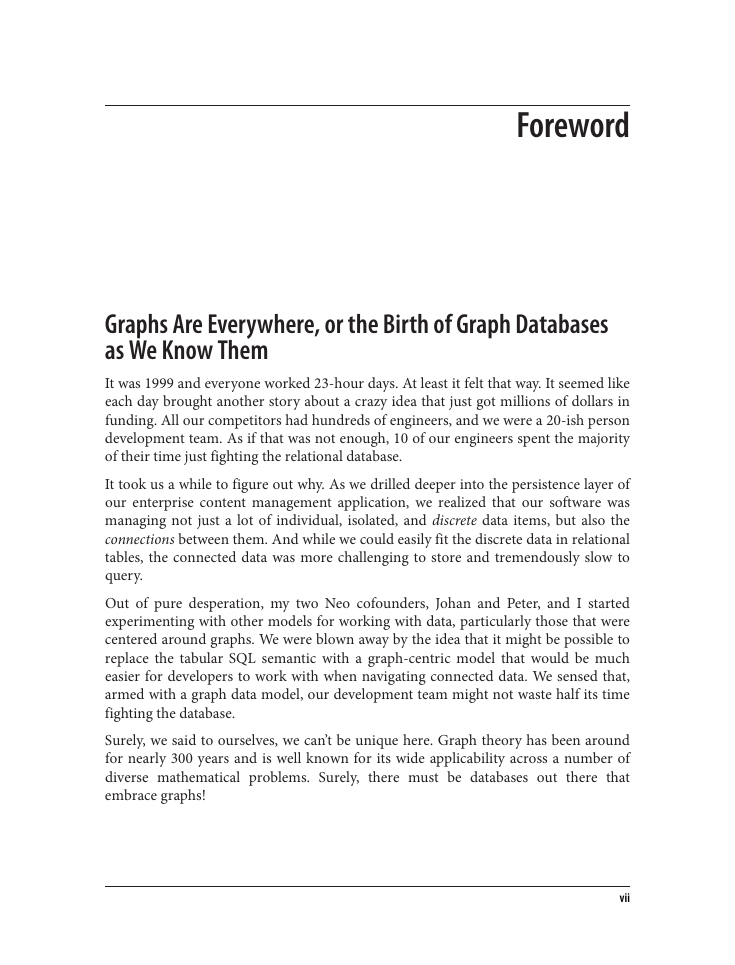Cover
Copyright
Table of Contents
Foreword
Graphs Are Everywhere, or the Birth of Graph Databases as We Know Them
Preface
About the Second Edition
About This Book
Conventions Used in This Book
Using Code Examples
Safari® Books Online
How to Contact Us
Acknowledgments
1. Introduction
What Is a Graph?
A High-Level View of the Graph Space
Graph Databases
Graph Compute Engines
The Power of Graph Databases
Performance
Flexibility
Agility
Summary
2. Options for Storing Connected Data
Relational Databases Lack Relationships
NOSQL Databases Also Lack Relationships
Graph Databases Embrace Relationships
Summary
3. Data Modeling with Graphs
Models and Goals
The Labeled Property Graph Model
Querying Graphs: An Introduction to Cypher
Cypher Philosophy
MATCH
RETURN
Other Cypher Clauses
A Comparison of Relational and Graph Modeling
Relational Modeling in a Systems Management Domain
Graph Modeling in a Systems Management Domain
Testing the Model
Cross-Domain Models
Creating the Shakespeare Graph
Beginning a Query
Declaring Information Patterns to Find
Constraining Matches
Processing Results
Query Chaining
Common Modeling Pitfalls
Email Provenance Problem Domain
A Sensible First Iteration?
Second Time's the Charm
Evolving the Domain
Identifying Nodes and Relationships
Avoiding Anti-Patterns
Summary
4. Building a Graph Database Application
Data Modeling
Describe the Model in Terms of the Application's Needs
Nodes for Things, Relationships for Structure
Fine-Grained versus Generic Relationships
Model Facts as Nodes
Represent Complex Value Types as Nodes
Time
Iterative and Incremental Development
Application Architecture
Embedded versus Server
Clustering
Load Balancing
Testing
Test-Driven Data Model Development
Performance Testing
Capacity Planning
Optimization Criteria
Performance
Redundancy
Load
Importing and Bulk Loading Data
Initial Import
Batch Import
Summary
5. Graphs in the Real World
Why Organizations Choose Graph Databases
Common Use Cases
Social
Recommendations
Geo
Master Data Management
Network and Data Center Management
Authorization and Access Control (Communications)
Real-World Examples
Social Recommendations (Professional Social Network)
Authorization and Access Control
Geospatial and Logistics
Summary
6. Graph Database Internals
Native Graph Processing
Native Graph Storage
Programmatic APIs
Kernel API
Core API
Traversal Framework
Nonfunctional Characteristics
Transactions
Recoverability
Availability
Scale
Summary
7. Predictive Analysis with Graph Theory
Depth- and Breadth-First Search
Path-Finding with Dijkstra's Algorithm
The A* Algorithm
Graph Theory and Predictive Modeling
Triadic Closures
Structural Balance
Local Bridges
Summary
Appendix A. NOSQL Overview
The Rise of NOSQL
ACID versus BASE
The NOSQL Quadrants
Document Stores
Key-Value Stores
Column Family
Query versus Processing in Aggregate Stores
Graph Databases
Property Graphs
Hypergraphs
Triples
Index
About the Authors
















 2023年江西萍乡中考道德与法治真题及答案.doc
2023年江西萍乡中考道德与法治真题及答案.doc 2012年重庆南川中考生物真题及答案.doc
2012年重庆南川中考生物真题及答案.doc 2013年江西师范大学地理学综合及文艺理论基础考研真题.doc
2013年江西师范大学地理学综合及文艺理论基础考研真题.doc 2020年四川甘孜小升初语文真题及答案I卷.doc
2020年四川甘孜小升初语文真题及答案I卷.doc 2020年注册岩土工程师专业基础考试真题及答案.doc
2020年注册岩土工程师专业基础考试真题及答案.doc 2023-2024学年福建省厦门市九年级上学期数学月考试题及答案.doc
2023-2024学年福建省厦门市九年级上学期数学月考试题及答案.doc 2021-2022学年辽宁省沈阳市大东区九年级上学期语文期末试题及答案.doc
2021-2022学年辽宁省沈阳市大东区九年级上学期语文期末试题及答案.doc 2022-2023学年北京东城区初三第一学期物理期末试卷及答案.doc
2022-2023学年北京东城区初三第一学期物理期末试卷及答案.doc 2018上半年江西教师资格初中地理学科知识与教学能力真题及答案.doc
2018上半年江西教师资格初中地理学科知识与教学能力真题及答案.doc 2012年河北国家公务员申论考试真题及答案-省级.doc
2012年河北国家公务员申论考试真题及答案-省级.doc 2020-2021学年江苏省扬州市江都区邵樊片九年级上学期数学第一次质量检测试题及答案.doc
2020-2021学年江苏省扬州市江都区邵樊片九年级上学期数学第一次质量检测试题及答案.doc 2022下半年黑龙江教师资格证中学综合素质真题及答案.doc
2022下半年黑龙江教师资格证中学综合素质真题及答案.doc